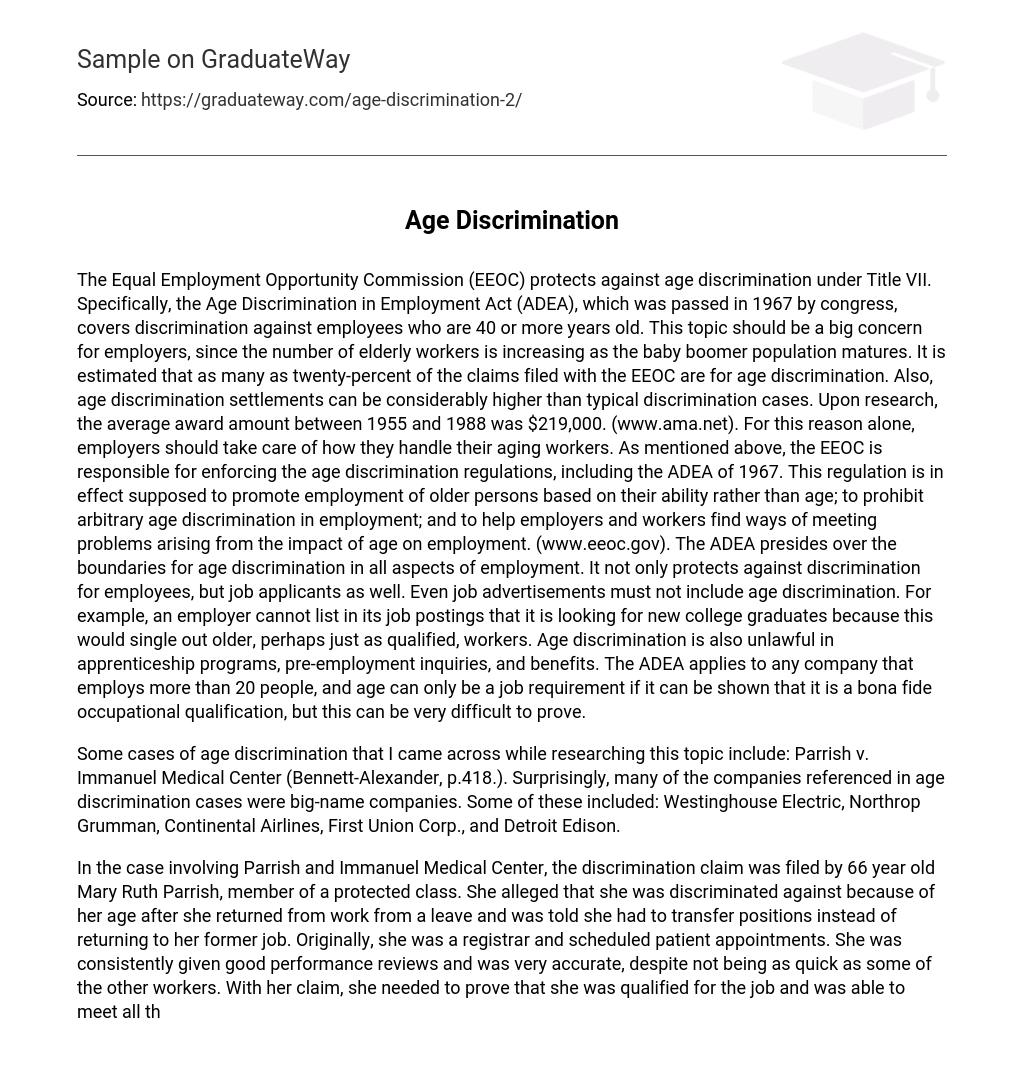The Equal Employment Opportunity Commission (EEOC) enforces Title VII to protect individuals from age discrimination. In 1967, Congress passed the Age Discrimination in Employment Act (ADEA) to combat discriminatory practices against employees aged 40 and above.
Employers find this topic significant as the aging baby boomer generation leads to a rise in the number of elderly workers. Reports suggest that around twenty percent of claims filed with the EEOC are related to age discrimination, and settlements for these cases often surpass those for other forms of discrimination. According to research by AMA, the average compensation awarded in age discrimination cases from 1955 to 1988 amounted to $219,000 (source: www.ama.net).
Employers should pay special attention to their older employees because of the EEOC’s enforcement of age discrimination laws. The EEOC is responsible for ensuring compliance with regulations like the ADEA of 1967, which seeks to encourage employment based on skills rather than age-based discrimination, prevent unjustified age bias at work, and help employers and workers with age-related employment matters (source: www.eeoc.gov).
The Age Discrimination in Employment Act (ADEA) prohibits age discrimination in all aspects of employment, encompassing job applicants and employees. This prohibition extends to job advertisements, which must not discriminate based on age. For example, employers cannot specify a preference for new college graduates as this would unjustly exclude older qualified workers. The ADEA also safeguards against age discrimination in apprenticeship programs, pre-employment inquiries, and benefits.
If a company has more than 20 employees, the ADEA is applicable to them and allows age to be considered as a job requirement only if it can be substantiated as a legitimate occupational qualification. Nevertheless, establishing such qualification can pose challenges.
While researching age discrimination, I came across various instances that underscore this problem. Parrish v. Immanuel Medical Center (Bennett-Alexander, p.418.) is a specific case worth mentioning. It is important to note that several renowned companies have been implicated in age discrimination lawsuits. Notable examples include Westinghouse Electric, Northrop Grumman, Continental Airlines, First Union Corp., and Detroit Edison.
The discrimination claim in the Parrish v. Immanuel Medical Center case was brought by Mary Ruth Parrish, a 66-year-old member of a protected class. Parrish accused the hospital of age discrimination when she was required to transfer positions upon returning from a leave of absence, instead of being allowed to resume her former job as a registrar. Despite not being as fast as some of her colleagues, Parrish consistently received positive performance evaluations and demonstrated high accuracy. To support her claim, she had to demonstrate that she was qualified for the position and capable of meeting all legitimate job requirements.
Immanuel Medical Center could not provide enough evidence to support their assertion that Parrish was slow and unable to adapt to new technology. They were obligated to prove that her job performance and contributions did not meet the set objectives, regardless of her age. However, they were unable to meet this requirement. It is worth noting that Parrish consistently received positive performance evaluations.
More and more companies are now acknowledging the value of older workers, although it has taken time to fully understand their diverse qualifications. Many seniors choose not to retire at 62, either because of financial worries or a personal desire to keep working. However, age discrimination lawsuits can arise from downsizing practices within a company.
Due to economic downturns, companies often downsize their workforce, with older employees being the most affected. Although some companies offer early retirement packages, they typically retain younger workers with less seniority to minimize expenses. Consequently, older employees who are let go often face significant challenges in securing new employment.
The primary concern for businesses is to reduce the likelihood of facing age discrimination lawsuits. Taking measures to prevent such lawsuits is generally more cost-effective than going through a lengthy and expensive trial. So, what preventive actions can businesses take?
The initial stage involves recognizing age discrimination as a significant matter. Subsequently, a company should internally evaluate its culture and ascertain employees’ perceptions of their treatment and that of older workers. Effective communication plays a crucial role in the functioning of a business. Additionally, the company should conduct research on applicable regulations and observe how other businesses are handling this issue. If deemed necessary, policies, training, recruiting, hiring practices, and job descriptions may require comprehensive evaluation and potential revision.
The focus should be on prevention rather than documenting possible offenses. The key to preventing claims lies in maintaining high employee morale. To achieve this, it is important to show older workers that they are valued and have a place in the company environment.





